

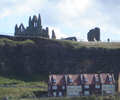 The impressive ruins of Whitby Abbey loom above the town from their position on a headland to the east of the River Esk. The current ruins are the remains of a Benedictine monastery that was founded after the Norman conquest, but the same site was also the home of Streoneshalh Abbey, an more important establishment that played part in the conversion of the Anglo-Saxons and was the site of the Synod of Whitby in 664 in which the Northumbrian church chose to follow the rites of Rome rather than the Celtic church.
The impressive ruins of Whitby Abbey loom above the town from their position on a headland to the east of the River Esk. The current ruins are the remains of a Benedictine monastery that was founded after the Norman conquest, but the same site was also the home of Streoneshalh Abbey, an more important establishment that played part in the conversion of the Anglo-Saxons and was the site of the Synod of Whitby in 664 in which the Northumbrian church chose to follow the rites of Rome rather than the Celtic church.
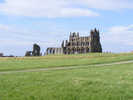 The original Whitby Abbey was founded in 657 by Oswy, king of Northumbria. The first abbess, St. Hilda of Whitby, had been abbess of Hartlepool Abbey and was the grand-niece of King Edwin, the first Christian king of Northumbria. She remained Abbess until her death in 680 and gained an impressive reputation during her lifetime.
The original Whitby Abbey was founded in 657 by Oswy, king of Northumbria. The first abbess, St. Hilda of Whitby, had been abbess of Hartlepool Abbey and was the grand-niece of King Edwin, the first Christian king of Northumbria. She remained Abbess until her death in 680 and gained an impressive reputation during her lifetime.
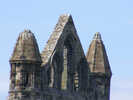 Whitby had been founded as a Celtic monastery. This meant that there was no large central church, but instead a whole series of small buildings used as monastic cells and chapels. There may have been a common dining room. Whitby was a double monastery with both nuns and monks. The Celtic church differed from the Catholic church in a number of ways. The two churches calculated the date of Easter differently, and used different tonsures. They were also organised differently. The Catholic church had a rather more ridge structure of dioceses, with bishops based in urban centres and a strict hierarchy. The Celtic church was centred in the monasteries and bishops were more like wandering preachers. By the 660s it was clear that Northumbria would have to decide which of the two rites to follow, and in 664 a large number of church leaders met at the Synod of Whitby. The synod decided to adopt the Roman practice, and this became the standard in Northumbria.
Whitby had been founded as a Celtic monastery. This meant that there was no large central church, but instead a whole series of small buildings used as monastic cells and chapels. There may have been a common dining room. Whitby was a double monastery with both nuns and monks. The Celtic church differed from the Catholic church in a number of ways. The two churches calculated the date of Easter differently, and used different tonsures. They were also organised differently. The Catholic church had a rather more ridge structure of dioceses, with bishops based in urban centres and a strict hierarchy. The Celtic church was centred in the monasteries and bishops were more like wandering preachers. By the 660s it was clear that Northumbria would have to decide which of the two rites to follow, and in 664 a large number of church leaders met at the Synod of Whitby. The synod decided to adopt the Roman practice, and this became the standard in Northumbria.
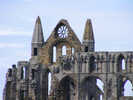 St. Hilda died in 680 (the same year in which she founded a new nunnery at Hackness). The monastery survived for another two hundred years, but was laid waste during Viking raids in 867-870 and was then abandoned. There may have been a minor revival by 1066, when Whitby was known as either 'Prestebi' - the habitation of priests - or 'Hwitebi' - the white settlement - although the first anem could have simply referred to the forty or so ruined monastic buildings on the headland.
St. Hilda died in 680 (the same year in which she founded a new nunnery at Hackness). The monastery survived for another two hundred years, but was laid waste during Viking raids in 867-870 and was then abandoned. There may have been a minor revival by 1066, when Whitby was known as either 'Prestebi' - the habitation of priests - or 'Hwitebi' - the white settlement - although the first anem could have simply referred to the forty or so ruined monastic buildings on the headland.
Whitby Abbey was the home of Caedmon, known as the 'father of English poetry'. He was said to have been a shy man who preferred the life of a cowherd to singing in the choir, until he had a dream in which an angel asked him to sing. His only surviving work is 'Caedmon's Hymn', one of the older surviving works in Old English.
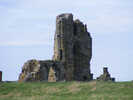 The second abbey was founded by Reinfrid, a former soldier who had served under William the Conqueror. He was inspired to try and restore the monastic life of the north of England, and convinced William de Percy to give him the ruined abbey at Whitby and land to support it. This second abbey was less historically significant, although it did suffer in the turbulent period after the Norman Conquest. The monks were forced away from the coast in the 1070s, and split. One party, under the second prior, Serlo de Percy, went to Hackness, while another, under Stephen of Whitby, founded a monastery at Lastingham before moving to York.
The second abbey was founded by Reinfrid, a former soldier who had served under William the Conqueror. He was inspired to try and restore the monastic life of the north of England, and convinced William de Percy to give him the ruined abbey at Whitby and land to support it. This second abbey was less historically significant, although it did suffer in the turbulent period after the Norman Conquest. The monks were forced away from the coast in the 1070s, and split. One party, under the second prior, Serlo de Percy, went to Hackness, while another, under Stephen of Whitby, founded a monastery at Lastingham before moving to York.
The monks were soon back at Whitby, and the monastery settled into a long period of fairly uneventful prosperity. Only one visitation is recorded, carried out by Archbishop Melton in 1320. The only real problem found here was some serious debt and a solution was easily found.
The abbey church was rebuilt in the thirteenth and fourteenth centuries. In its final form it had an eastern aisle with seven bays to allow space for seven extra chapels, each with their own altars. The sacristy was built against the southern aisle of the long presbytery.
The nearby church of St. Mary's was built to serve the village that grew up around the abbey. There are some twelfth century elements in this building.
The abbey was damaged in 1914 when shells from two German battleships hit the west front, but despite that the abbey remains are still very impressive, with one end and most of the sides of the main church still complete to roof level.
Grid Reference: NZ 904 112